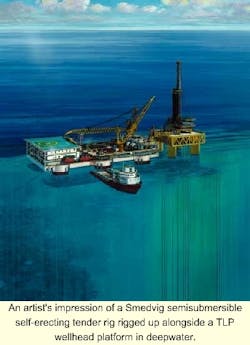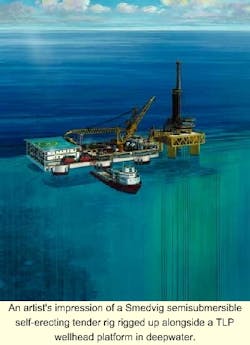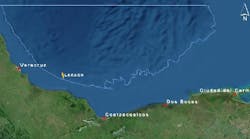Using a self-erecting tender rig for drilling from floating installations with dry wellheads in deepwater could be more cost-effective in benign climates such as in Southeast Asia, Brazil and West Africa, according to drilling contractor Smedvig. The company, which operates the world's largest tender drilling fleet, has designed its new semisubmersible tender rig with this purpose in mind.
The newbuild, named West Alliance, is under construction at the Keppel Shipyard in Singapore and is due for delivery in late 2001. The design of this vessel, which is based on that of the West Menang, another of Smedvig's semisubmersible tender rigs, has been modified with larger columns and pontoons and incorporates a higher variable deckload and more storage capacity for liquid mud and brine.
The eight anchor winches are larger, compared to the wire currently used on Smedvig's West Menang and West Pelaut, which are the company's other semisubmersible tender rigs. The mooring of tender rigs in deepwater has been facilitated by the development of lightweight mooring ropes such as Dyneema, which is made of high-modular polyethylene and polyester, combined with a pre-laid mooring system.
Two key questions arise in considering whether tender-assisted drilling is beneficial in these circumstances:
- Are there savings to be made compared with alternative solutions?
- Is it technically feasible, given that there is no experience of tender rigs working with deepwater floaters?
Cost savings
The major economic benefit of using a tender rig is that the cost of providing an integrated platform rig is avoided. Calculations made by Anders Leland, Marketing Manager with Smedvig Asia, suggest that for a wellhead tension-leg platform (TLP), a saving of at least US$140 million (net present value) can be achieved.
This figure is made up of the cost of the platform rig itself and the reduction in the platform construction cost, which results from the fact that the TLP can be smaller. The operating weight of the self-erecting tender is only about one quarter that of a platform rig, while the size of the deck required for the derrick equipment set is also significantly smaller since mud systems, power, pipe deck, accommodation, and so on, are contained on the tender, Leland says.
Smedvig has nearly 30 years' experience as a tender rig operator, but this is mainly with fixed platforms - none of its tender rigs has previously been used to drill from a floating platform. So, the company decided to investigate the issue using floating platform data from reliable sources:
- Modec, which has developed the Moses wellhead TLP design
- Aker Maritime, which has delivered several Spar platforms.
The design criteria used in the studies were water depths of 6,000 ft for the Spar and 4,000 ft for the TLP. The key feasibility issue is whether the rig can be moored alongside a TLP or Spar in such a way as to maintain an optimal distance from the installation, neither approaching so close as to run the risk of colliding with it, nor moving so far that the lines carrying power, mud and other functions from the tender to the platform come under strain.
The design environmental conditions used were the 100-year storm conditions in Angola Block 17. Criteria for sea conditions were set at a significant wave height of 13.8 ft, a one-minute wind of 43 knots, and a surface current of three knots.
Mooring systems
For the TLP, the study considered a steel wire catenary system with the additional use of two pre-tensioned "stretcher" ropes between the tender and the platform. The stretcher ropes, the purpose of which is to further constrain the relative excursion between the tender and the platform, are 3 1/4-in. nylon rope pre-tensioned to a relatively low value - 50 kips. By maintaining positive tension in the stretchers it is possible to ensure that a minimum controllable distance is always maintained to the TLP.
For the Spar platform study, a taut-leg mooring (TLM) system consisting of wire and polyester rope was used, which is similar to the mooring system adopted for the Spar platform. Studies showed that it is possible to moor the tenders in depths down to 6,000 ft by using a pre-installed mooring system combined with the semisub tender rig's own mooring system upgraded from 2 1/4-in. to 2 1/2-in. diameter wire rope. In the case of the TLP, the maximum relative distance was 84 ft and the minimum distance was 73 ft. In the Spar's case, the maximum relative distance was 105 ft when using 2 1/2-in. wire combined with 3-in. polyester rope and 92 ft when using 2 1/2-in. wire combined with 5-in polyester rope. The minimum distance was 36 ft.
These motions are considered to be within the operating limits of the tender semisubmersible and would not require disconnection from the platform, Leland says.
The deepwater tender drilling rig concept is being examined by oil producers, and Unocal Indonesia is looking at it for development drilling on the West Seno TLP in 3,000 ft water depth off Kalimantan. This contract is expected to be tendered soon. Unocal is considering the possible use of either a barge-type tender or a semisubmersible-type tender. Smedvig has discussed the tender drilling concept with operators with deepwater acreage off West Africa. Since weather conditions off Angola and West Africa generally are somewhat harsher than offshore Kalimantan, the contractor considers the semisubmersible-type tender more appropriate for deepwater applications in this region.






